Content:
- Introduction
- Beat Location and Accessibility
- Mitton Beat Grayling Fishing Trips
- Buying a River Ribble Trust Fishing Day Ticket
- Other Species of Fish
Introduction
Introduction
The River Ribble is a beautiful river in the North West of the UK that is famed for its diverse fishery and picturesque surroundings. Among the many beats that run along its banks, you can fish Mitton Beat for wild grayling, brown trout, sea trout and salmon on a day ticket from the River Ribble Trust.
Whether you’re an experienced angler or new to fishing, the Mitton Beat offers everything you need for a memorable day on the water. The beat is characterised by a series of runs, riffles, and deeper pools that provide perfect conditions for catching grayling, trout, sea trout and salmon when in season. Grayling fishing is especially good during the colder months.
In this guide, we’ll explore the location, how to obtain permits, the pools on the beat, and the variety of fish you can catch, and we’ll share some recent success stories.
River Ribble Trust Mitton Beat Location and Accessibility
The Mitton Beat is located on the River Ribble in the heart of the stunning Ribble Valley. The river runs through picturesque landscapes, offering anglers a beautiful and peaceful environment to fish in. The beat itself is situated near the village of Mitton, which is just a short drive from the market town of Clitheroe and the historic village of Whalley.
If you’re coming from further afield, the area is easily accessible from the M6, making it convenient for both local and out-of-town anglers.
For those using public transport, the nearest train station is Clitheroe, which is around a 10-minute drive away. Parking is available close to the beat, ensuring easy access for anglers bringing gear and equipment.
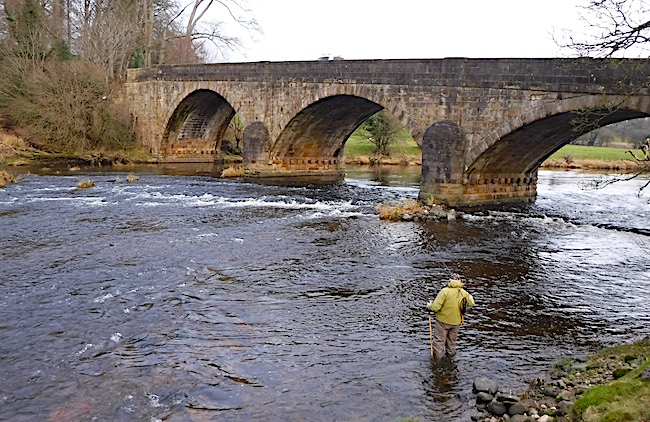
Grayling Fishing Trips to the River Ribble Trust Mitton Beat
November Grayling Fishing Trip
The extremely wet weather in North Wales during November pushed the Welsh Dee to an unfishable level. So, with no viable grayling fishing on the Dee, we decided to fish the River Ribble that had returned to a fishable level following the recent rain.
After a little deliberation, we decided to explore the day ticket beat of the Ribble and Calder at Mitton, which I’d wanted to fish for a couple of years.
There had been an overnight frost (-2oC), and the ground was still frozen when we parked the car in the layby next to the Aspinall Arms, which is a great place for food and a beer after fishing.
The River Ribble level was clearing after the last spate and had dropped to a fishable level (0.68m Henthorn gauge). It was still below zero when we made our way to the river, so we walked down through the wood to the bottom of the beat and located the pools and glides suitable for fly fishing.
At the junction pool with the River Hodder, we met a coarse angler who’d been fishing for a couple of hours and had caught some nice grayling and chub trotting maggots through the pool.
The bottom of the beat consists of a short (ca. 500m) section of the River Calder that flows into the Ribble (know as the Calder Foot). The Calder was carrying a little colour, and with the lack of rising fish, we chose to fish a team of nymphs on a tight line leader set-up.

I set up my 10ft 3wt nymphmaniac fly rod to fish two nymphs spaced 18” apart on 4lb fluorocarbon (point: #12 pheasant tail nymph with a 4mm metallic orange tungsten bead, dropper: #14 pink squirmy worm with a 3mm pink tungsten bead).
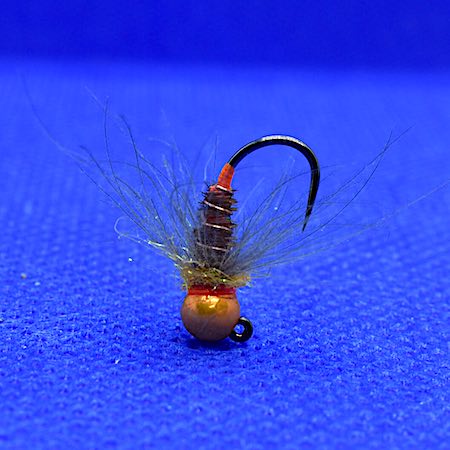
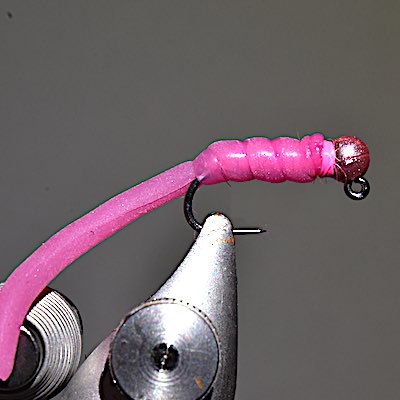
In the first pool, I caught a few grayling, mainly on the pheasant tail nymph. So I switched the squimy on the dropper to a #16 hare’s ear nymph with a 2mm copper tungsten bead. The following video highlights some of the grayling that I caught fishing the Lanchashire Calder down to the junction with the River Ribble.
Graham also caught a couple of beautiful Calder grayling to about 1lb on nymphs in the fast-water sections of the pools.
After a late lunch, we headed back up the River Ribble to fish the pool below the junction with the River Hodder. I stopped off to fish the fast water on the tree-lined bank while Graham continued upriver to fish the Hodder Junction Pool.
I decided to fish the fast water with a team of wet flies from the safety of the margins (point; #14 pheasant tail nymph; middle dropper, #14 black hopper; top dropper, #14 March Brown Spider).
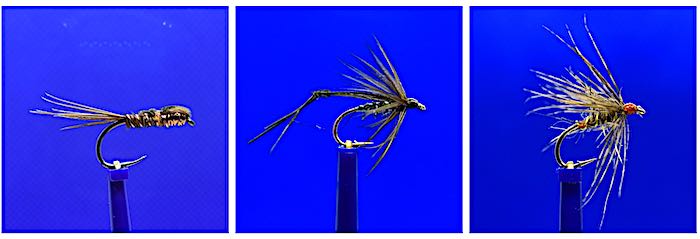
Fishing the wet flies across and down produced a couple of grayling that fell for the black hopper on the middle dropper.
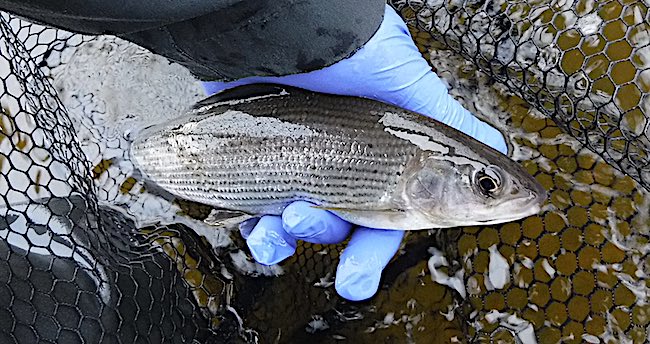
For the final hour, I joined Graham fishing at the Hodder Junction Pool. Earlier, he’d caught a lovely OOS brown trout (ca. 1lb) fishing a hare’s ear nymph in the fast water at the head of the pool.
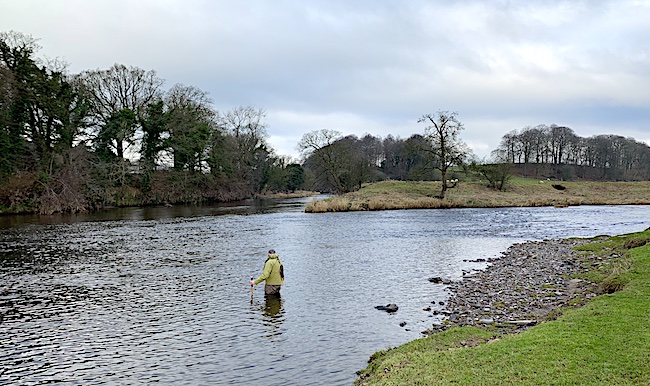
When I’d caught up with him, he was targeting a few fish rising in the tail of the pool with a Griffith’s Gnat dry fly.
After a couple of missed takes, he landed a lovely grayling…
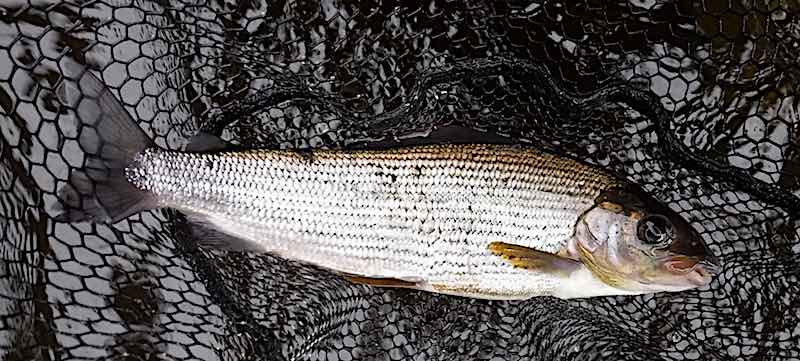
I left Graham fishing the tail with the dry fly to fish the head of the pool with the team of wet flies I’d been using earlier. After catching a few small grayling on the March brown spider, my rod bent around into a bigger fish that darted into the fast water. Following a few dicy moments, I netted a beautiful River Ribble Trust grayling that had fallen for the black hopper on the middle dropper.
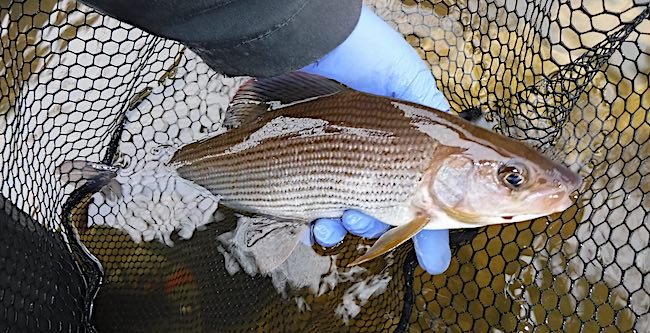
Fishing on until the sun started to set produced a couple more grayling before it was time to head home.
January Grayling Fishing Trip
January proved to be another very wet month, and grayling fishing on the Welsh Dee had been a non-starter all month. Therefore, we made another trip to fish the River Ribble Trust Mitton beat for grayling.
After two days of dry weather, the river level had fallen back to 0.66m from 1.5m (Henthorn gauge). Clear overnight skies had led to a ground frost, but this thawed quickly in the winter sunshine as we walked downriver to fish the Calder Foot.
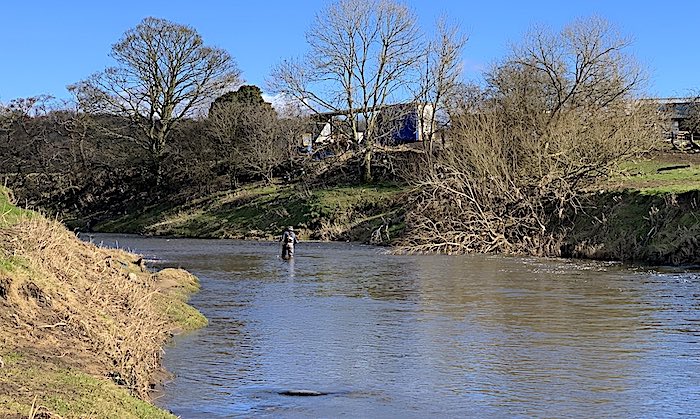
In the sunshine, the air temperature had begun to warm, but we started the day fishing nymphs because we hadn’t seen any grayling rising.
Using my 3wt nymphing rod I fished a team of three nymphs spaced 18” apart on 4lb fluorocarbon (point: #12 olive & copper tungsten jig-back nymph, dropper: #14 pink squirmy worm with a 3mm pink tungsten bead, top dropper #14 hares ear nymph with a 2mm copper tungsten bead).
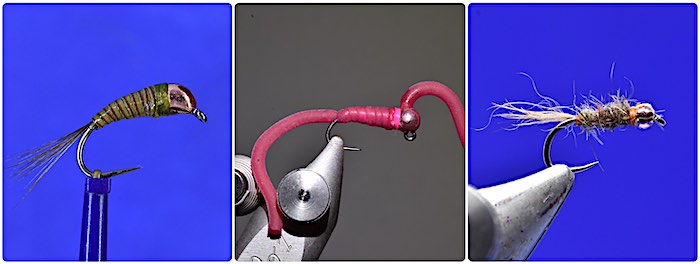
The following video covers some of the grayling that I caught fishing the Calder Foot that joins the River Ribble.
How to Buy a River Ribble Trust Fishing Permit
To fish on the Mitton Beat, you’ll need to obtain a river ribble fishing day ticket from the River Ribble Trust. The Trust manages the fishing rights on the beat, ensuring sustainable management and promoting conservation practices.
Day ticket permits can be purchased online through the River Ribble Trust website.
When purchasing a permit, it’s also important to be aware of the Trust’s fishing regulations. These include catch-and-release policies for certain species, restrictions on fishing during spawning seasons, and guidelines on using non-invasive bait.
Other Species of Fish
While the Mitton Beat is renowned for its grayling and game fish, the River Ribble also hosts a variety of coarse fish, making it a great spot for anglers looking for a mixed bag of fish.
- Barbel: Barbel can be found in sections of the Ribble, particularly in deeper, faster flows. Although less common in the Mitton Beat itself, there are still opportunities for anglers willing to fish for this powerful species.
- Chub: Known for their hard-fighting nature, chub are another species that can be found on the Mitton Beat. These fish are most active during the warmer months and are a popular target for anglers using bread, corn, or maggot.
- Dace and Roach: These smaller species provide a great option for anglers looking for action throughout the year. The fast flows and shallower sections of the beat are perfect for catching dace and roach, especially when fishing with light tackle.
The variety of species makes the Mitton Beat a versatile location for anglers, and it’s not uncommon to enjoy a day of mixed-species fishing, even if your primary target is grayling and trout.
Conclusion
The River Ribble Trust Mitton Beat offers anglers a fantastic opportunity to fish for wild trout and grayling in one of the most beautiful areas of the UK. With its varied pools, accessible permits, and diverse range of species, it’s a destination that caters to both novice and seasoned anglers. Whether you’re targeting grayling with nymphs or enjoying a mixed-species day, the Mitton Beat promises a memorable experience every time you visit.
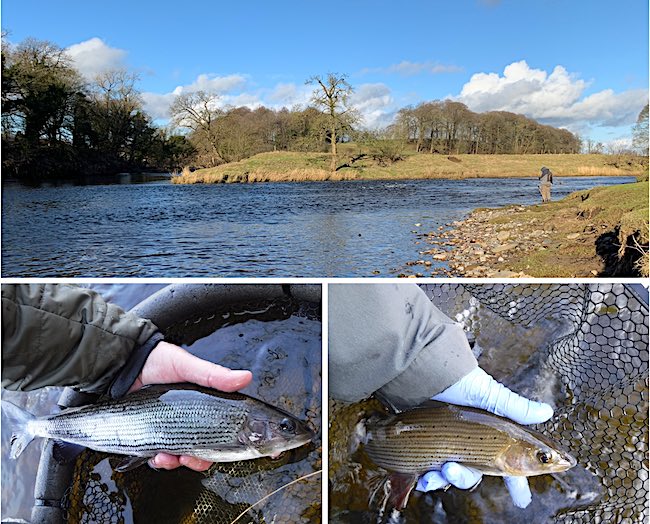
Really interesting blog Andrew and good to see another venue. The Ribble looks a great water and gives a wide range of different waters. I imagine during the brown trout season it would be a great water. Does it maintain a good flow during the summer months? I think you have produced one of your best videos showing the flies you used and good descriptions of the water. Well done and thankyou.
Hi Iain,
The River Ribble is a classic spate river and drops to its bones during a prolonged dry spell. However, if it is a wet summer, the river runs off quickly, and the fishing is usually great.
Tight lines, Andrew